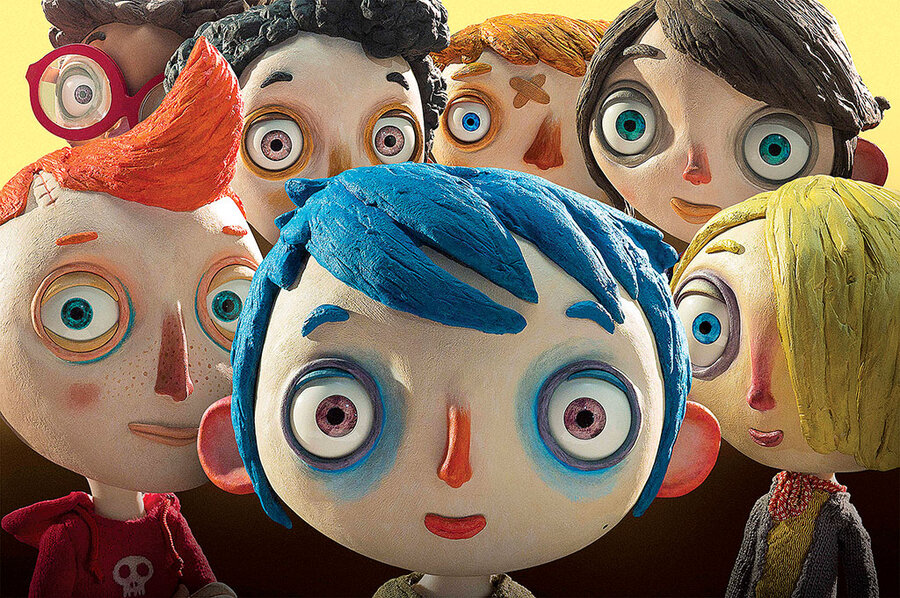‘My Life as a Zucchini’ avoids sentimentality
Loading...
It never fails to amaze me that movies featuring animated characters can engender the same deep emotional responses from audiences as live-action films. The most recent example of this magical alchemy was “The Red Turtle,” and now, even more improbably, we have the French-Swiss film “My Life as a Zucchini” (screening in the United States with English subtitles and dubbed); both were Oscar nominees. I say “improbably” because this stop-motion feature utilizes plasticine figures with enormous heads and eyes. But this is no children’s cartoon special. Mr. Potato Head and his buddies never had such expressive eyes.
The Zucchini of the title is the nickname for the fatherless 9-year-old Icare (voiced by Gaspard Schlatter), whose name, translated into English, is Icarus, far too imposing a moniker for such a risk-averse lad. He much prefers to be called Courgette, French for Zucchini, which was the nickname bestowed by his alcoholic mother. When he accidentally causes her death, he is sent by a kindly policeman, Raymond (voiced by Michel Vuillermoz), to a local orphanage, where he meets a motley group of 10-year-olds with similarly troubled pasts, including the bullying, red-haired Simon (Paulin Jaccoud); the shy, dinosaur-loving Ahmed (Raul Ribera); the even shyer Alice (Estelle Hennard), who hides behind a thick mop of hair; and Camille (Sixtine Murat), a new arrival with whom Courgette tentatively bonds.
Swiss-born director Claude Barras, who makes his feature debut, and his screenwriter, Céline Sciamma, adapting the French novel “Autobiography of a Courgette,” understand that just because a movie is kidcentric doesn’t mean it has to be kid stuff. (Sciamma is a well-known director in her own right and recently collaborated on the script for André Téchiné’s intermittently powerful coming-of-age drama “Being 17.”)
French-language movies about the travails of childhood have a long and rich legacy, including such masterpieces as “Poil de carotte,” “Zéro de conduite,” “The Red Balloon,” “Forbidden Games,” and “The 400 Blows.” “My Life as a Zucchini” is not in their league, but, in its own way, it achieves the same end: an enraptured view of life as seen entirely within the orbit of childhood imaginings.
It accomplishes this in the most honest of ways: by avoiding sentimentality almost entirely. The three-dimensional manipulated models in “Zucchini” may be made of plasticine, but they register as real people. The bigness of their faces does not mean they should be taken at face value. The childless Raymond, for example, understands Courgette’s woes and becomes, imperceptibly and inevitably, his father figure. Simon, who is first presented as a standard-issue, loud-mouthed scourge, soon reveals himself to be much more complicated and caring. (At one point he laments, “We’re all the same. There’s nobody left to love us.”) His developing friendship with Courgette is beautifully rendered, as is Courgette’s connection to Camille, with whom he and the other orphans share a marvelous interlude in the snow and during which the two talk about their hopes and fears under a star-bright sky.
The frame-by-frame stop-motion techniques utilized by Barras are incredibly painstaking, often resulting in no more than three usable seconds of film per day’s shooting. I realize it is not altogether legitimate to bring up the arduousness of a film’s production as a badge of distinction. After all, plenty of awful big-budget live-action movies require equal amounts of heavy lifting. Still, it’s an indication of the dedication of the collaborators of “Zucchini” that they invested so much care. Even the score, by Swiss musician Sophie Hunger, is resonant.
There’s an encompassing sense of wonderment in this film that allows for both sadness and transcendent uplift. This is what you would expect from a movie that tries to get childhood right, for a change. The film is a real rarity, made even more so by the fact that what has moved us so profoundly are a bunch of pop-eyed plasticine figures. Grade: A- (Rated PG-13 for thematic elements and suggestive material.)







